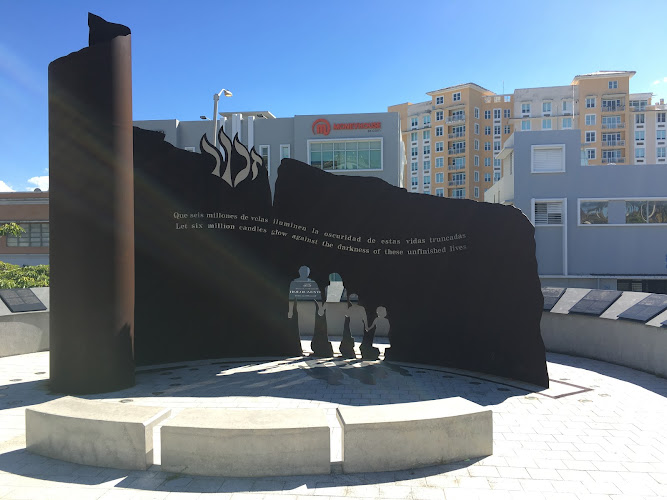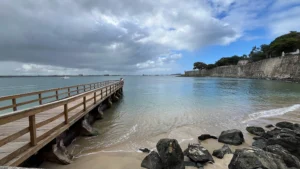
About Holocaust Memorial Monument
About the Holocaust Memorial Monument in San Juan
The Holocaust Memorial Monument of San Juan, Puerto Rico, serves as a stark reminder of the atrocities of World War II. Unveiled on April 2012, it stands solemn and profound across from the Capitol Building, evoking the memory of the millions of Jewish and non-Jewish victims who perished in the Holocaust.
In a thoughtful design by artists Michael Berkowicz and Bonnie Srolovitz, the monument presents a poignant sculpture titled 'In the Shadow of Their Absence.' Crafted from weathering steel that symbolizes the passage of time, the structure is set against the backdrop of black granite, dictating an air of weighty remembrance. This concept reflects on the lives left unfinished, as the granite's reflective surface returns the gaze of visitors, reminding them of their duty to remember.
Interpreting the symbolism gives rise to numerous emotions. The monument not only commemorates the six million Jewish lives lost but also the countless others affected by Nazi atrocities. This includes those who stood against the regime and paid with their very existence. Given Puerto Rico's ties to Jewish history, such as the rescue of Jewish passengers from the Lod Airport attack, the monument resonates deeply with the island's respect for life, love of neighbor, and values of fellowship and mutual contribution.
The presence of the Holocaust Memorial next to the Capitol is significant. It implores comprehension and remembrance from lawmakers and citizens alike, embodying a message that extends beyond the Jewish community. It calls all to vigilance against hatred and to ensure such a tragedy never recurs. With each visitor, the memorial's shadows evoke shared human values and the indelible impact of history.
Best Time to Visit
The Holocaust Memorial Monument in San Juan, Puerto Rico, offers a somber yet vital historical experience. Notably, the climate of Puerto Rico is tropical, with the potential for rain throughout the year. The dry season, from December to April, presents the most favorable weather conditions for outdoor activities.
Morning Visits: For a serene experience, families and individuals might prefer the cooler, tranquil hours just after dawn. The soft light of the morning sun highlights the weathering steel of the monument, offering reflective moments without the crowd.
Weekdays Versus Weekends: According to TripAdvisor reviews, weekdays generally see fewer visitors, making them ideal for those seeking a more private space for contemplation at the monument. Families and tour groups usually find weekend visits more convenient, but they should expect more company.
Public Events: It's wise to check the calendar for public holidays and commemorative events. Visiting during such times can provide a richer understanding, as public ceremonies add layers to the experience.
Seasonal Considerations:
- Winter (December to February): Mild temperatures and less rainfall.
- Spring (March to May): Slightly warmer, with a moderate chance of rain.
- Summer (June to August): Hot with the highest rainfall—typically less comfortable for outdoor tours.
- Autumn (September to November): Warm and humid, with possible tropical storms.
In terms of weather and foot traffic, it is advisable to visit between December and April, early on a weekday, thus balancing a comfortable climate with peacefulness, allowing visitors to fully absorb the gravity of the memorial's message.
Nearby Attractions
Adjacent to the solemn Holocaust Memorial Monument in San Juan, Puerto Rico, visitors can find a rich array of sites that convey a deep sense of history and remembrance. Situated on the enrapturing Constitution Avenue, this poignant landmark offers more than a moment of reflection; it’s a gateway to further exploration of San Juan’s cultural tapestry.
Near the Memorial, the Capitol Building stands as a testament to the vibrant democracy of Puerto Rico. Its impressive architecture invites those interested in politics and history to witness where the island’s legislative processes unfold.
A short journey from the Holocaust Memorial reveals a path known as 'The Walk of Nine Presidents', honoring the nine U.S. presidents who have visited San Juan. Life-size bronze statues offer visitors a unique historical insight and are perfect companions for thought-provoking photographs.
For individuals seeking tribute to other significant historical narratives, the Memorial commemorating the 1972 Israel Lod Airport massacre is another profound site nearby, emphasizing themes of peace and tolerance.
Those who wander into the heart of Old San Juan will be met with cobbled streets and colorful buildings, embodying four centuries of Spanish rule. Historic sites, like forts and colonial architecture, promise an afternoon well spent. The city’s fabric narrates tales of heroes, with monuments and memorials, such as those dedicated to Puerto Rican police, inspiring respect and veneration among visitors.
Languages spoken in the area, including Hebrew, Spanish, and English, reflect the diverse influences that shaped San Juan, turning it into a melting pot of Caribbean culture and history. As visitors leave the Holocaust Memorial and venture through San Juan, each landmark serves as a waypoint on a journey through the legacy of resilience and the universal commitment to human dignity.


